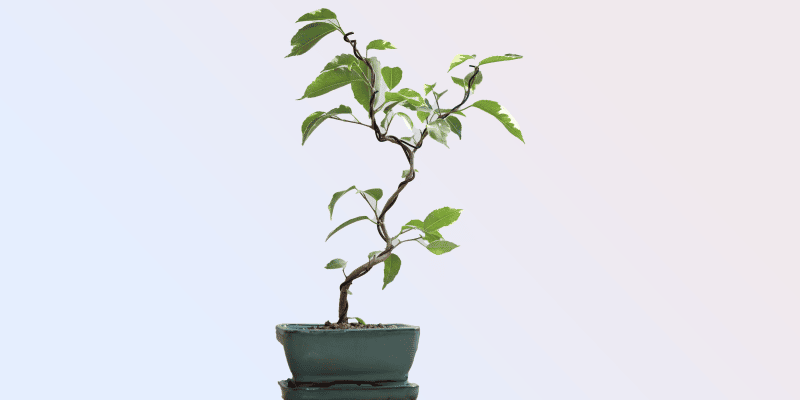Have you ever wanted a super cute tree in your living room?
Weeping fig (Ficus benjamina) would be one of the best choices you can make. They’re super easy to care for, propagate, and can even be used for Bonsai!
We’ll cover the most common issues we see for weeping figs in our care guide, including yellowing leaves, leaf drop, and the essential soil mix to keep these plants happy and thriving!
(We also have a bonus propagation guide at the end if you want young plants to hand out to your friends!)
Table of Contents
Weeping Fig Care Guide
History, habitat, and characteristics

Weeping Fig (Ficus Benjamina) is a prime example of the Ficus family, one of the most popular plants to grow indoors. Its history is almost as rich as its appearance, ranging from a helpful air-filtering houseplant to an actual source of wood used to craft 19th-century chapels in Australia.
Ficus Benjamina is one among hundreds of species of the Ficus genus, including fiddle-leaf figs and fan palms. What should stand out first is its gently weeping foliage and woody, gnarled trunk.
Native to the regions of Southeast Asia, Australia, India, China, and parts of the tropical Pacific, this plant not only plays an important role in its native habitat, but is also a wonderful chance to bring a touch of the outdoors… inside!
Its leaves are a fair bit smaller than other Ficus trees, and grow indoors to typically around 5-7 feet tall.
You’ll also notice that its trunks can be braided decoratively without any harm to the plant, and you can even purchase them already established this way.
Weeping fig trees are also very popular to keep as a Bonsai if you want a more tamed look.
Ficus Benjamina ‘Variegata’ is an alternative variety with beautiful, white-bordered variegated leaves. Unlike most ficus plants, this variety will grow a bit more slowly.
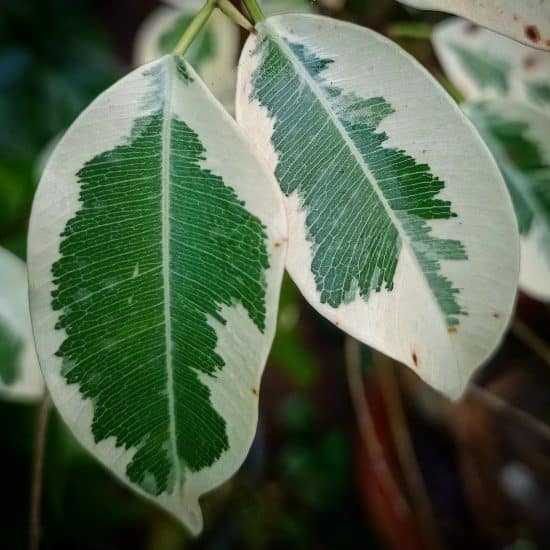
Not so fun fact: each species of Ficus is pollinated by its own corresponding species of wasps in the wild.
Of course, these wasps are exclusive to the Weeping fig’s native habitat, so don’t expect it to produce viable seeds outside of its tropical range. Hopefully, you’re out of the range of those wasps too, so we’ll cover how to propagate via stem cuttings in a later section.
Okay, let’s get right into our care guide!
Light

Ficus benjamina loves a bright light placement. They absolutely thrive in it and will take all the light you can give them. Well, almost all: they don’t do well in direct light, so make sure that if they’re near a window, they’re not directly in front. Send some of that light to the rest of the room!
Some plants absolutely adore being rotated and moved around a home, and adapt well. Ficus benjamina is not one of those plants. It really don’t like to move much, so pick a spot and keep it there as it adapts.
Lighting tips:
- Bright, indirect light is best for Weeping figs, but they can tolerate lower light conditions.
- If leaves start to pale, it’s likely not receiving enough light; place in a sunnier spot to regain its vibrant hue.
Water
Weeping figs love a lot of water, with an important exception: they hate moist soil. That may sound picky, but it’s actually pretty easy to solve with the right soil mix (which we’ll cover in a later section).
The important thing to remember is that you let the soil dry out and don’t let the roots of this plant sit wet for too long. So water as frequently as it lets you.
How do you know it’s letting you? Touch the soil down to your second knuckle. If it’s dry, add some water!
If you notice yellow leaves with your weeping fig, that’s a sure sign that it’s underwatered.
Generally, if the soil drains well, you’ll be able to water this plant once or twice a week in the spring and summer, and every other week in the winter.
Tips:
- Water your weeping fig when the top 1-2 inches of soil feels dry.
- Use either filtered or distilled water that is room temperature to prevent shock.
- Water the soil until it’s saturated and let the rest drain out.
- Increase water during the growing season of spring and summer; reduce during the fall and winter.
- Look for droopy leaves or yellow discoloration as signs of overwatering or underwatering, respectively.
Temperature and humidity
Ficus benjamina plants are pretty tolerant of changes in temperature and humidity, but they do have some ideal ranges.
For temperature, try to park that thermostat north of 65. Generally, 65 – 85 degrees F is an acceptable range, and really try not to go under 60 or much higher than 85.
For humidity, winter can be a challenge, but fortunately, the weeping fig tree will let you know in a very… confrontational way that the humidity is getting too low. Green leaves will just start falling off without yellowing or browning. If you notice this, it’s time to raise the moisture in your air.
While clustered plants can help increase local humidity, a pebble tray placed beneath the pot will also essentially act as a humidifier. The tray should be filled with pebbles and shallowly submerged in water to allow water evaporation to increase the humidity level right by your plant by 4-5%, without affecting the overall indoor humidity.
It is important to avoid misting the leaves, as this can attract diseases or pests. Experiments conducted at the University of Toledo have shown that low relative humidity levels can cause the leaves of the Weeping Fig to dry and shrivel up.
Soil and planting
Ficus benjamina is a bit picky when it comes to soil, but it doesn’t like anything all that exotic, so don’t worry. Like we mentioned in the water section above, a fast-draining soil is essential for this plant.
Why?
It’s a pretty fast-growing plant that needs lots of nutrition – that means, light, water, and even fertilizer. It also has roots that don’t love staying wet. So the compromise is a fast-draining soil that we can water frequently. That way, everyone is happy (primarily the Weeping fig).
When to repot? Once you notice roots coming out of the drainage holes of your Weeping fig tree.
Keep in mind:
- Ficus benjamina does not like being root bound, so let’s accommodate its requests for a larger pot.
- Those drainage holes are essential for keeping our soil dry and fast draining.
- Repotting can be stressful on ficus trees. If your plant is overly rootbound, this stress is a lot harder for it to deal with, and those roots aren’t going to navigate through the soil as effectively, so it’s better to address this early.
Weeping figs grow fast. Those dark green leaves want to just soak up the sun! This is often what makes it such an affordable plant to buy from the nursery – they can grow a lot of weeping figs quickly and cheaply.
For us, that pace of growth means we want to not just give them plenty of light and water, but also fertilizer. Don’t use it in the winter, but during the spring and summer (your plant’s active growing season) you can fertilize every couple of weeks, diluted to half strength.
For the soil mixture, we recommend:
- 50% regular potting soil
- 50% cactus soil
If you don’t have cactus soil available, you can go with a 70% potting to 30% perlite mixture as well. This is going to ensure you have the basis for a fast-draining soil that can still provide the essential nutrients to these plants.
Propagation guide
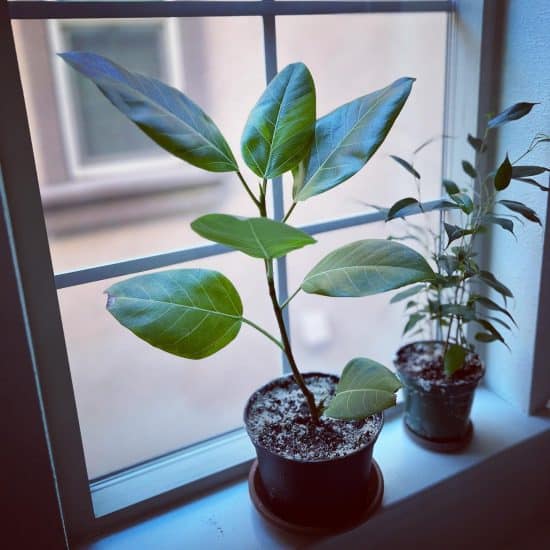
Propagation of Ficus benjamina is pretty easy. You won’t be able to use its seeds, but stem propagation works great.
Propagating your weeping fig
You’ll want to gather some scissors or pruning shears (make sure to sterilize with alcohol or boiling water), a new pot (with fresh potting soil) or a jar.
(You can pass on the rooting hormone.)
- Find a plant with plenty of healthy growth, and pick a branch with at least 5 full leaves.
- Remove leaves from the bottom of that stem until you have 3-4 inches of growth with exposed leaf nodes.
- Prepare the same potting soil we recommend above, give it a good soaking, and then plant your stem cuttings inside.
- Take a plastic bag, or you can even use a cut plastic bottle (a 2-liter bottle cut in half, say) and put it over like a little dome to keep in the moisture. Place your cuttings and pot in a sunny location, watering every few days.
- Within 2-3 weeks you should have root growth and you can treat your cuttings normally. Just don’t fertilize for a while!
If you’re wondering if there’s a root system down there in the dirt, you can give it a little tug and test for resistance. Or if replanting, just check them out directly!
Common issues
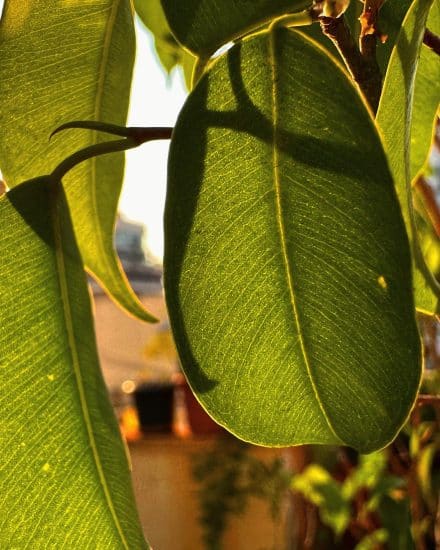
Ficus plants are widely kept, which means most of the issues you’ll see? Thousands of other people have had the same problems, and you’ll be part of a huge community of Ficus owners who can help troubleshoot them, us included!
The most common issues I see with Weeping fig plants are yellowing leaves and suddenly dropping leaves. Let’s dive into both.
Yellowing leaves
Yellowing leaves are almost always a sign of not enough water with Ficus benjamina. With other plants, it can mean different things, but in my experience, it means the soil is probably retaining water a bit too much, so it’s not being watered as frequently, and the plant just isn’t able to grab everything it needs.
If you need to, certainly add perlite to the soil to help it drain and start watering more frequently. You should see improvement in a few weeks.
Leaves dropping off
It may look like your weeping fig is happy: glossy green leaves, no leaf spot, no yellow or brown tips… but they keep falling off. Is this normal?
Usually this is a sign of low humidity or root rot. With low humidity, you’ll really not see a lot of signs other than slower growth, which you might not notice if you haven’t had a weeping fig before.
With root issues, there will be other signs, like moldy soil, bugs that seem to be attracted, and soil that just doesn’t dry out.
These have different solutions, but they aren’t contradictory. For moisture, try grouping your weeping fig with other plants or adding a humidifier. For the roots, we’ll cover that in the section below.
Mature plants will sometimes experience leaf drop without any underlying issues, especially lower leaves, or if they’ve been occluded by newer growth.
Diseases and pests
Ficus benjamina suffers a lot of the same issues as other ficus trees, mainly when it comes to pests. In fact, this plant is generally so easy to care for that most issues are probably due to pests and were probably out of your control, so don’t be too hard on yourself if you’re having any issues.
Pests
Mealybugs, scale insects, and spider mites all love this plant, even when it’s healthy and thriving. Normally those are a sign of deeper issues, but not with a Ficus tree. Instead, let’s just be happy they’re some of the easiest problems to fix and they all have the same solution, so it’s not too important to identify which you have.
You’ll want to spray water to remove any pests, then use a Q-tip dipped in alcohol to remove any webbing or bugs that are left. Give the leaves a dose of neem oil, then repeat in a few weeks. Ficus plants don’t love to be moved, so it’s sometimes better to move the other plants away to isolate it instead.
Root rot
The obvious sign will be your weeping fig dropping all of its leaves at once. Root rot a common disease in weeping figs and almost always caused by poor drainage. As the roots on your plant rot in moist soil, the plant becomes weaker and less able to resist fungi.
First, uproot your plant and cut off any affected roots, tossing out the soil. Repot with a 50/50 mix of cactus/regular potting soil, and cut back watering to just when the soil is completely dry.
Fungicides are not needed, so skip those. The key here is water and drainage.
Conclusion
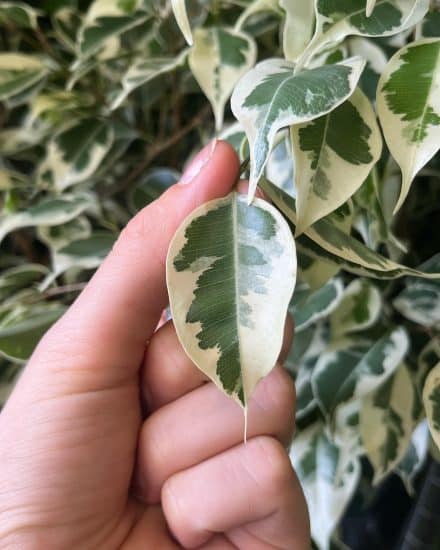
By this point, you should know how to take care of your weeping fig so that you aren’t weeping too!
A quick Weeping Fig care recap for us:
- Bright indirect light makes these indoor plants happy and keeps them growing fast. Direct sunlight, however, will lead to brown leaf tips. Variegated varieties will need a bit more light than their light green counterparts.
- Water thoroughly, but make sure excess water drains. Leaf spotting can sometimes be from softened water or minerals, so definitely try filtered water at room temp.
- Fertilize during the growing season, diluted to 50% once or twice a month.
- Don’t keep the soil moist for too long, and make sure it drains well. If it isn’t draining, check your soil composition and that your pot has adequate drainage.
- If you notice your fig dropping leaves all at once while they’re still green, this is a sure sign of low humidity. Try to raise it above 40% to give your plant a glimpse of the tropical climates where they’re found.
If you have any questions or suggestions for us here at Plantcarefully, get in touch on Twitter or Instagram!
FAQ
Do Weeping figs need direct sunlight?
Nope! In fact, direct sun should be absolutely avoided.
Where should you place a Weeping fig ficus tree?
Weeping figs thrive with an east or west facing window if they’re available. Park it a few feet away. Indirect sunlight is key for this plant, so give it literally as much as you can.
Does Weeping fig purify air?
Weeping fig has been studied extensively for its air filtration properties and studies have shown that it does clean air of toluene, xylene, and formaldehyde, all of which are found in homes.
Should I mist a Weeping fig?
Best not to – misting a Ficus benjamina can attract pests and weaken its leaves. If you need to raise humidity, it’s much better to cluster other plants together or use a pebble tray.
Why are the leaves falling off my Ficus benjamina?
Likely due to root rot or not enough humidity. You’ll need to make sure humidity is above 40%. If it is, the next step is to inspect and clip those roots.

